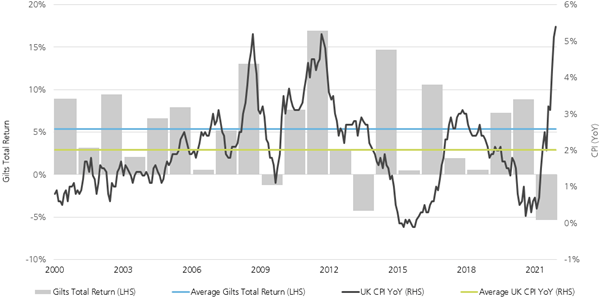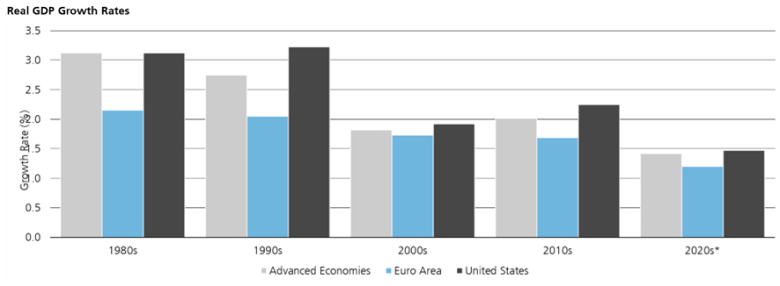With global bonds yields moving higher, fixed income markets are looking increasingly attractive, but the risks must be managed appropriately.
In October 2012 Austrian daredevil Felix Baumgartner set three extraordinary world records in the space of about 10 minutes. Using a helium balloon and capsule to fly, a then record 39 kilometres into the stratosphere, he jumped to freefall a record 36 kilometres, reaching a maximum vertical speed of nearly 1,400 km/h and so becoming the first human to break the sound barrier without any form of engine power. The two hour balloon ride sounds Ok. A 36km freefall, including a near fatal uncontrolled spin? Not for me, thank you. But I salute the courage and the imagination1. Today, billionaire moguls compete with sophisticated rocketry to blast passengers into Earth orbit and beyond. Baumgartner’s achievement was based on hard science and human courage, but there is still an air of romanticism today in the story of a man who travels to the edge of space in a balloon and returns to earth in a parachute. More Jules Verne than George Lucas.
Meanwhile, for those who want the adrenaline rush of high-altitude freefall without the chore of travelling to space, well, I suppose there is always the bond market.
Between 2000 and the end of 2021 owners of the broad index of UK Government bonds (known as Gilts) earned a serene 5% average annualised return2. There was some volatility along the way, but the worst loss in any year during that time was around 5%; nothing too alarming. And given that headline Consumer Price Inflation (CPI) averaged just 2% over this same period, Gilt owners probably spent much of the last 20 years happy in their decision to own risk-free government bonds with a return well above average inflation, and without too much drama (Chart 1).
Chart 1: Gilt returns vs inflation over the last 20 years

Risk free? Hmmm. The smooth journey upwards held no clues about the dizzying descent to come. By late September this year Gilt returns fell nearly 30% year-to-date3, the Bank of England was forced into a rushed bail-out of some pension funds whose largest holdings were those very same ‘risk-free’ gilts, monetary policy was thrown into chaos and a government was very nearly brought down. If that wasn’t enough, UK investors were already mired in CPI inflation among the highest in developed markets (11.1% at the last count4).
We need not dwell on the details of this painful debacle, which have been covered at length in the media, but it would be a serious mistake to imagine that similar market ructions could not unfold elsewhere. While the finer points in this case were unique to the UK, many economies around the world are buffeted by similar turbulence. In fact it is striking how frequently some themes apply globally, and how closely interwoven they are with the outlook for fixed income markets. We may summarise them as:
- the rapidly-changing inflation story flowing from tight labour markets, post-pandemic fiscal largesse and high energy costs
- the changing monetary policy story when central banks were first slow to react, but now move quickly and aggressively to raise interest rates, and will most likely continue into 2023
- a fiscal story which means that many governments still run large deficits that need to be funded by bond markets. (In the UK this was tried via an idea as old as fiat money itself; the magic money tree given a new lease of life as unfunded government spending to a promised land of higher growth and lower inflation. Fine, as long as someone will lend you the money)
- hidden leverage
Nobody can afford to be complacent. In this febrile world, one or two bad policy choices and financial markets may quickly spiral out of control almost anywhere. The complacency of many Gilt owners was to imagine that historic returns and volatility could be maintained into infinity, even though we live in a radically different world.
As yields have moved higher globally, fixed income markets are looking increasingly attractive, but the risks must be managed appropriately.
What are the best opportunities today?
The trick for investors will be to capture some of the undoubted opportunities bond markets offer while keeping adrenaline levels firmly in check. A good starting point is simply to avoid one-dimensional strategies that might be prone to the destabilizing volatility seen in UK Gilts a few weeks ago. Undiversified choices that worked well in the past carry hidden risks today. Proper diversification and sound active management are essential to driving great investment returns in today’s world.
Taking this as a starting point, what seem to be the best opportunities now? Here are four candidates:
1. US Broad Market:
The US bond market is the world’s most actively traded and diverse market for investors. The Bloomberg US Broad Market Index, a popular bond index followed by many investors is worth over USD30 trillion and today yields a shade over 4.5% – levels not seen since 2009. The overall market is very high quality (AA+), and spans a range of sectors including government bonds, mortgage-backed securities, corporate bonds and some supranational issuers such as the World Bank. Although the Federal Reserve (Fed) has hiked interest rates aggressively, given yield levels today, and since the market has already priced more rate rises next year, the downside risks for bond holders are far less than they were a year ago. If inflation does start to moderate, the US probably offers among the best risk-and-reward opportunities for bond investors today.
2. US Treasury Inflation Protected Securities (TIPS):
Although not part of the US Broad Market index mentioned above, TIPS are a crucial part of the opportunity set for active bond management. Over the long run, the real (i.e., after inflation) yield on TIPS should roughly match the real growth rate of the economy. For several years following the global financial crisis (GFC) real yields were supressed to levels below the real growth rate – a key driver behind extraordinary returns from equities and other risks assets in years following the GFC.
However, as the Fed has tightened monetary policy to cool growth, so TIPS yields have risen – to the extent that long-term TIPS today yield around 1.75%. Using a combination of historic data and International Monetary Fund forecasts, Chart 2 highlights how real growth rates have been on a steady secular decline across developed markets – a trend that is expected to continue over the next five years. Given that today’s TIPS yields now run at, or even slightly ahead of, forecast real growth rates they look much better value than at many points since the GFC. As they have the obvious benefit of paying a coupon plus US inflation, they will also provide investors with good downside protection if inflation resists the Fed’s attempts to bring it back to target.
Chart 2: Real GDP growth rates have been declining for 40 years

3. Go Global:
As a corollary to US broad market exposure, the ultimate diversification (and therefore a high chance of good outcomes) will be found by investors who can broaden their horizons to embrace global bond markets. I mentioned earlier the themes that run consistently around the world and pose challenges for policy makers and investors alike. However, these will unfold in different ways across different time horizons. The challenges faced by the Fed and the ECB are superficially alike (inflation well above target), but have somewhat different causes (and therefore required responses). A sound active strategy will rotate across countries and sectors as over time (Gilts looked a death-trap in September, but now the UK strains to be a paragon of fiscal virtue). Investors must be nimble.
4. European High Yield:
I admit this looks somewhat counterintuitive given the challenges ahead for European economies. However, markets have moved quickly to reprice these risks and yields still sit at close to 10-year highs, while projected default rates in 2023 are relatively low, improving expected risk-adjusted returns (many companies do not need to refinance in the short term – a key risk for high yield investors). For sure some industry sectors are more vulnerable than others – so active management will be key to success. Returns will probably be more volatile than the other ideas here but long term investors stand to benefit the most.
These opportunities are not mutually exclusive and my point about proper diversification means that the most successful outcomes will probably depend on a careful blend of them all.
If there is a lesson to be learned from the recent experience of bond holders in the UK it is the need to move on from highly concentrated holdings, even in what appear to be low risk assets. In my experience most investors prefer the balloon ride to the freefall too.
1The height record was subsequently beaten by the equally heroic Alan Eustace in 2014.
2BoA ML UK Gilt Index, returns gross of fees
3BoA ML UK Gilt Index, returns gross of fees
4The Office for National Statistics, Consumer Prices Index (CPI), as at October 2022

